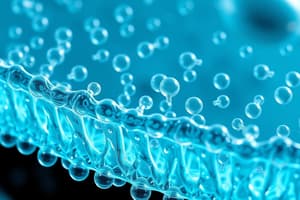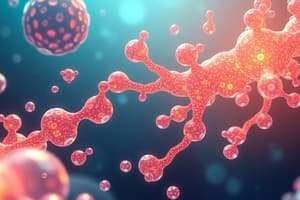Podcast
Questions and Answers
Cardiolipin is classified as a type of sphingophospholipid.
Cardiolipin is classified as a type of sphingophospholipid.
False (B)
Cardiolipin plays a significant role in mitochondrial function.
Cardiolipin plays a significant role in mitochondrial function.
True (A)
Cardiolipin contains two glycerol molecules in its structure.
Cardiolipin contains two glycerol molecules in its structure.
False (B)
Cardiolipin is known to stabilize respiratory enzymes in the lungs.
Cardiolipin is known to stabilize respiratory enzymes in the lungs.
Signup and view all the answers
The structure of cardiolipin is integral for maintaining the integrity of the mitochondrial membrane.
The structure of cardiolipin is integral for maintaining the integrity of the mitochondrial membrane.
Signup and view all the answers
Cardiolipin is primarily found in the plasma membrane of cells.
Cardiolipin is primarily found in the plasma membrane of cells.
Signup and view all the answers
Cardiolipin is synthesized from phosphatidic acid and specific acyl chains.
Cardiolipin is synthesized from phosphatidic acid and specific acyl chains.
Signup and view all the answers
Cardiolipin deficiency can lead to severe cardiovascular conditions.
Cardiolipin deficiency can lead to severe cardiovascular conditions.
Signup and view all the answers
Cardiolipin consists of two molecules of phosphatidic acid held by an additional glycerol through phosphate groups.
Cardiolipin consists of two molecules of phosphatidic acid held by an additional glycerol through phosphate groups.
Signup and view all the answers
Cardiolipin is primarily found in the outer mitochondrial membrane.
Cardiolipin is primarily found in the outer mitochondrial membrane.
Signup and view all the answers
Cardiolipin is the only phosphoglyceride that has antigenic properties.
Cardiolipin is the only phosphoglyceride that has antigenic properties.
Signup and view all the answers
Cardiolipin was first isolated from lung tissue.
Cardiolipin was first isolated from lung tissue.
Signup and view all the answers
Cardiolipin stimulates antibody formation.
Cardiolipin stimulates antibody formation.
Signup and view all the answers
The structure of cardiolipin allows it to be considered a simple lipid.
The structure of cardiolipin allows it to be considered a simple lipid.
Signup and view all the answers
Cardiolipin has a role only in energy metabolism.
Cardiolipin has a role only in energy metabolism.
Signup and view all the answers
Cardiolipin accumulates in the brain and is crucial for normal brain function.
Cardiolipin accumulates in the brain and is crucial for normal brain function.
Signup and view all the answers
Study Notes
Phospholipids
- Compound lipids containing phosphoric acid, fatty acids, a nitrogenous base, and an alcohol.
- Two classes: glycerophospholipids & sphingophospholipids.
Glycerophospholipids
- Major lipids in biological membranes.
- Glycerol-3-phosphate esterified at C1 and C2 with fatty acids.
- Usually, C1 has a saturated fatty acid and C2 has an unsaturated fatty acid.
Types of Glycerophospholipids
- Phosphatidic acid: simplest phospholipid, intermediate in triacylglycerol and phospholipid synthesis.
- Lecithin (phosphatidylcholine): most abundant phospholipids in cell membranes, storage form of choline, acts as a lipotropic factor (prevents fatty liver).
- Forms cholesterol esters, transporting cholesterol to the liver for excretion, preventing atherosclerosis.
- Prevents gallstones by solubilizing cholesterol in bile.
- Dipalmitoyl lecithin: contains 2 palmitic acid residues, important in lungs, prevents lung surface tension.
- Respiratory distress syndrome in infants is caused by a deficiency of dipalmitoyl lecithin.
- Cephalins (phosphatidylethanolamine): ethanolamine is the base, involved in blood clotting.
- Phosphatidylinositol: important component of cell membranes, mediates the action of certain hormones like oxytocin and vasopressin.
- Phosphatidylserine: contains serine, found in certain tissues.
- Cardiolipin: isolated from heart muscle, consists of two phosphatidic acid molecules linked by glycerol, important in inner mitochondrial membrane, antigenic.
Sphingomyelines
- Contain sphingosine, an amino alcohol, instead of glycerol.
- Ceramide is formed when sphingosine is attached by an amide linkage to a fatty acid.
- Important component of myelin, found in the brain and nervous system.
Niemann Pick's disease
- Accumulation of sphingomyelin in the liver due to a deficiency of sphingomyelinase enzyme.
- Leads to mental retardation and early death.
Ceramide
- Acts as a second messenger (signaling molecule), regulating apoptosis, cell cycle, and cell differentiation.
- With a 30-carbon fatty acid, it's a major component of skin, regulating water permeability.
Glycolipids
- Important component of cell membranes and nervous tissues.
- Cerebrosides are the simplest glycolipids, consisting of ceramide and one or more sugars.
- Sulpholipids (sulphatides) are cerebrosides with a sulfate group.
- Galactocerebroside and glucocerebroside are important glycolipids.
Structure of galactosylceramide
- A diagram of the galactosylceramide structure would be helpful here.
Cerebrosides (simple glycolipids)
- Hydrolysis gives sphingosine, fatty acid, and sugar.
- Classified based on the type of fatty acid:
- Kerasin (lignoceric acid), Narvon (nervonic acid), Oxynervon (oxynervonic acid), and Cerebron (cerebronic acid).
- Functions of cerebrosides:
- Their functions would need to be elaborated on.
Studying That Suits You
Use AI to generate personalized quizzes and flashcards to suit your learning preferences.
Related Documents
Description
This quiz explores the structure and function of phospholipids and their subclasses, particularly glycerophospholipids. Dive into the types of glycerophospholipids like phosphatidic acid and lecithin, and their significant roles in biological membranes and various physiological functions.




